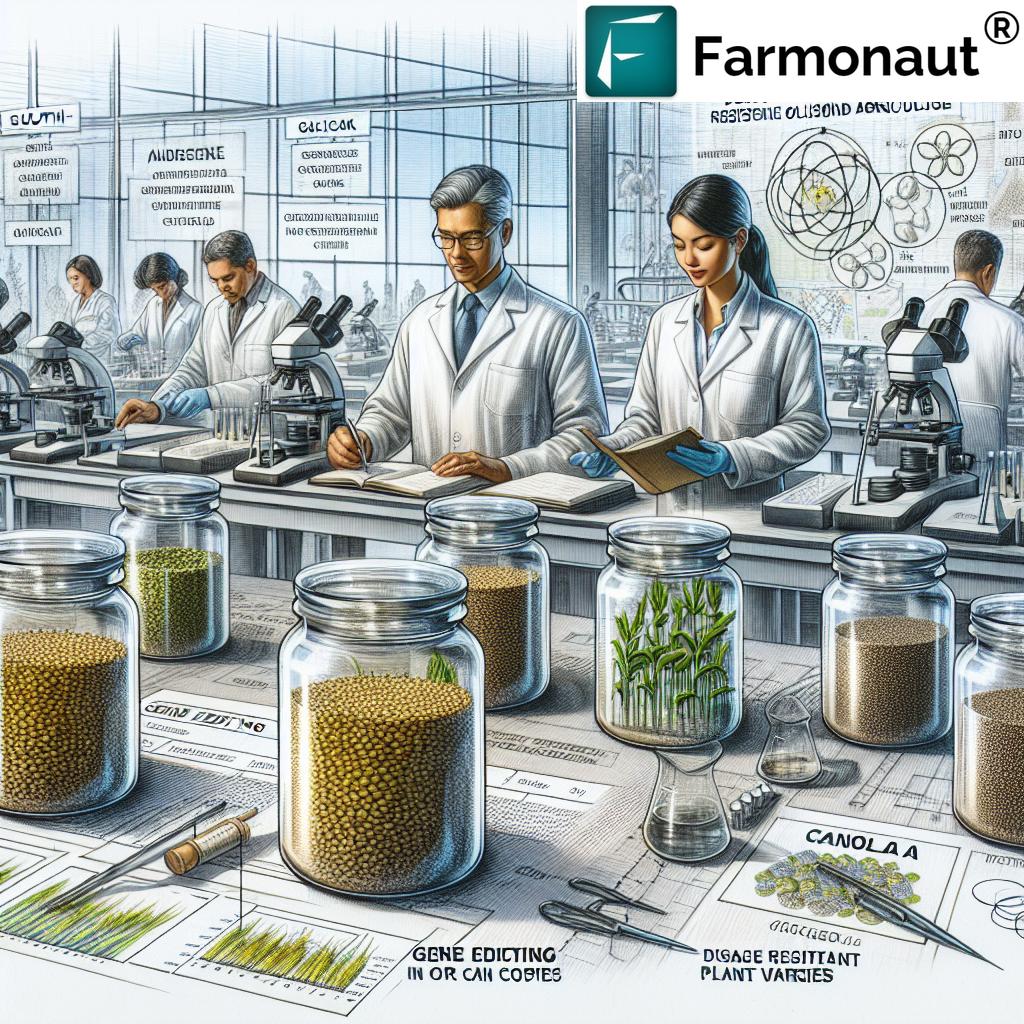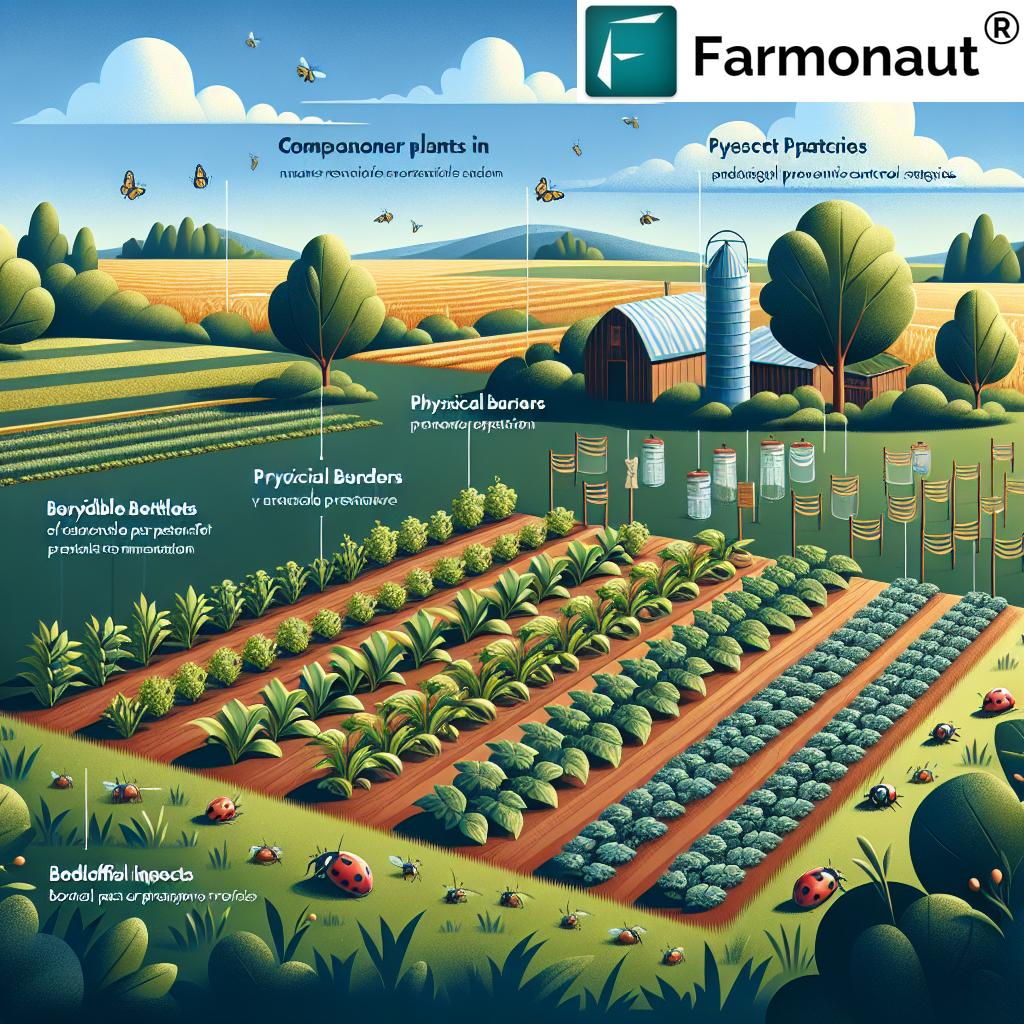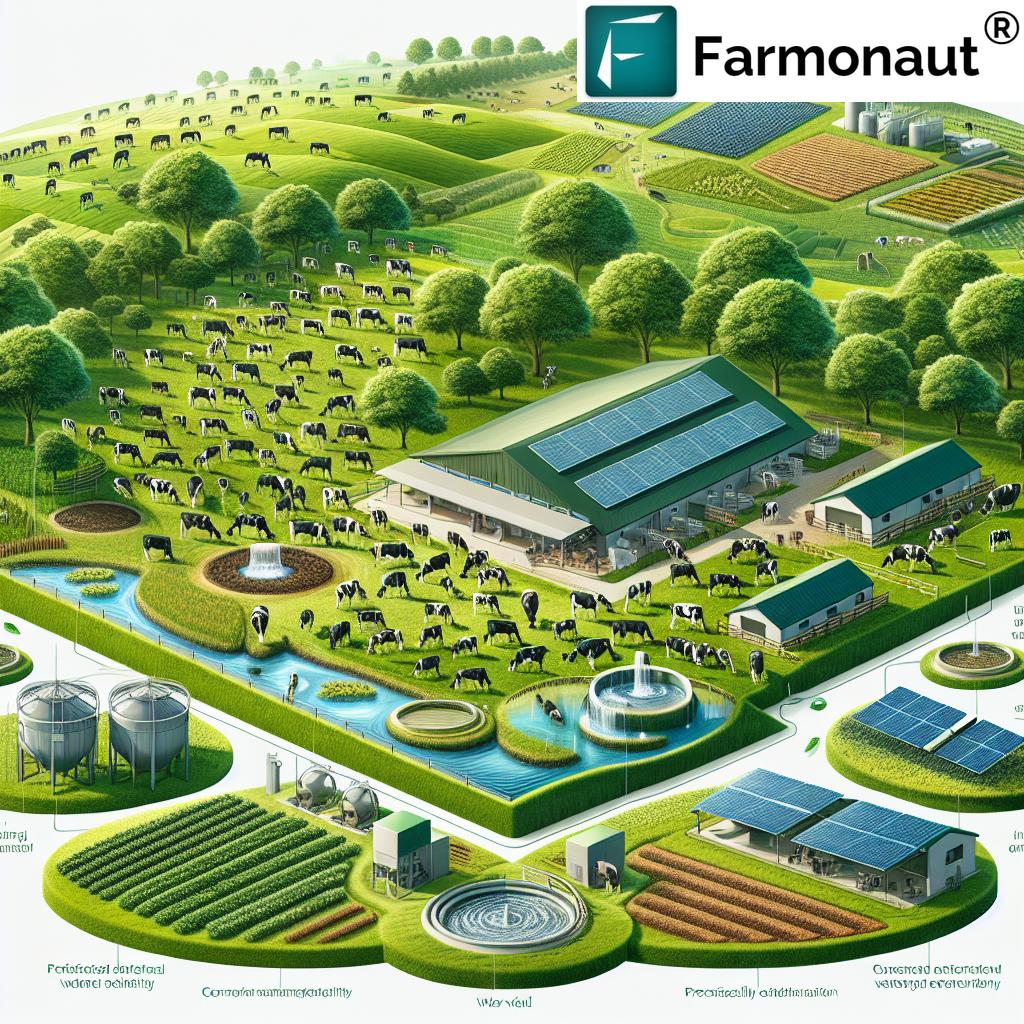Canola Disease Resistance: 5 Breakthrough Technologies Boost Yields
“Gene editing has increased canola disease resistance by up to 40%, significantly reducing crop losses in recent field trials.”
“Five breakthrough technologies have boosted canola yields by as much as 25%, revolutionizing sustainable agricultural productivity.”
- Introduction: The Urgency for Canola Disease Resistance
- The Importance of Gene Editing in Crops for Resistance and Yields
- 5 Breakthrough Technologies Driving Canola Disease Resistance
- Comparative Technology Impact Table
- Regulatory Policy for Gene Edited Crops: United States, EU & Global Impact
- Sclerotinia Management in Canola: New Solutions and Sustainable Progress
- How Farmonaut Supports Disease Management & Sustainable Agriculture
- Key Benefits of Breakthrough Disease-Resistant Plant Varieties
- Conclusion and Next Steps
- Frequently Asked Questions (FAQ)
Introduction: The Urgency for Canola Disease Resistance
As the world tilts toward sustainable agriculture, the role of advanced technology and gene editing in crops has never been more critical. Canola—a vital oilseed crop for farmers in Canada, the United States, the European Union (EU), and globally—faces relentless threats from plant diseases like Sclerotinia sclerotiorum (white mold), jeopardizing yields and farmer incomes. In the last decade, disease outbreaks have not only impaired crop productivity traits but have also imposed immense input costs on agricultural communities.
Our mission at Farmonaut is to support farmers and agricultural stakeholders by providing integrated, technology-driven solutions that complement and enhance the impact of these disease resistant plant varieties. Sustainable agricultural technology is no longer a futuristic ideal, but a present-day necessity—one that leverages gene-editing, advanced data analytics, and real-time advisory platforms to ensure robust yields and optimized resource use. This blog post comprehensively explores the latest breakthroughs in canola disease resistance, the science and policy behind them, and how our satellite-based platform empowers growers to maximize these innovations.
The Importance of Gene Editing in Crops for Resistance and Yields
The convergence of biotechnology and agricultural science has produced an array of tools enabling the precise improvement of crops. Gene editing in crops such as canola, soybean, and rice offers the potential for durable, targeted resistance against devastating plant diseases. Unlike conventional breeding, where desired traits are painstakingly introduced over multiple generations, gene editing platforms—like CRISPR and Cibus’ Rapid Trait Development System™ (RTDS)—allow for rapid, pinpointed genetic enhancements without introducing foreign DNA. This precision translates to a more robust, sustainable, and resilient farming sector.
- Speed: Traits can be developed within years, not decades. For farmers, this means faster access to innovative varieties optimized for their regional threats.
- Precision: Only the desired genes are altered, minimizing unintended effects on the plant or its productivity.
- Sustainability: Reduced dependence on chemical inputs for plant disease management solutions enhances environmental outcomes and farm profitability.
By integrating these advancements with real-time farm monitoring platforms like ours, we give stakeholders the ability to utilize technology for actionable, data-driven decisions that complement modern resilient canola varieties.
5 Breakthrough Technologies Driving Canola Disease Resistance
Canola disease resistance has entered a new era, with five major gene-editing platforms accelerating progress where conventional breeding methods cannot compete. Let’s navigate each technology, its operational principles, and its transformative impact on crop productivity traits and yields.
1. CRISPR/Cas9 Gene Editing
CRISPR/Cas9 has rapidly become synonymous with precision agriculture. By using a guide RNA and the Cas9 enzyme, scientists quickly target, cut, and modify specific sections of the canola genome, enhancing genes for disease resistance or silencing those prone to infection. This modular approach has enabled breeders in Canada, the United States, and Europe to produce varieties resilient against Sclerotinia and other pathogens.
- Eliminates the time-intensive process found in conventional breeding vs gene editing.
- Reduces dependency on fungicides for prominent plant diseases, lowering input costs for growers.
- Boosts both yields and environmental sustainability, as less chemical input means reduced runoff and soil contamination.
2. TALENs (Transcription Activator-Like Effector Nucleases)
TALENs are molecular scissors engineered from naturally occurring proteins, tailored to recognize DNA sequences unique to the canola or soybean genome. Their specificity has made them a prime tool in the rapid development of disease resistant plant varieties.
- Effective for complex genetic alterations in commercial oilseed crops.
- Have shown to increase resistance by introducing or deleting susceptibility genes with fewer off-target mutations.
3. Zinc Finger Nucleases (ZFNs)
ZFNs have paved the path for site-directed genome editing. Each “finger” of the protein recognizes a nucleotide triplet, allowing for customized genetic alterations in crops like canola and rice.
- Historically foundational in biotechnology, ZFNs are useful for introducing durable, multi-pathogen resistance traits.
- Can stack resistance genes, creating varieties that tolerate a range of plant diseases and shifting market threats.
4. RNA Interference (RNAi)
This platform suppresses the expression of specific genes susceptible to pathogens. When integrated with satellite-based resource management solutions like Farmonaut’s, the result is holistic, adaptable plant disease management solutions.
- Reduces reliance on broad-spectrum chemicals for sclerotinia management in canola and soybean.
- Enables the creation of regionally optimized resistance plans for farms in the United States, Canada, and beyond.
5. Gene Stacking
Gene stacking places multiple resistance genes—sourced through editing, RNAi, or various conventional methods—within a single canola or rice variety. This approach fortifies the crop against evolving diseases and environmental stressors.
- Multi-gene protection offers robust defense against pathogens like Sclerotinia and emerging crop threats across global regions.
- Catalyzes yield improvements, as stacked varieties display higher resilience even under intense pathogen pressure.
Comparative Technology Impact Table
| Technology | Mechanism | Estimated Increase in Disease Resistance (%) | Estimated Yield Improvement (%) | Implementation Timeline (Years) | Environmental Impact |
|---|---|---|---|---|---|
| CRISPR/Cas9 | Targeted gene editing using guide RNA and Cas9 enzyme | 35–40 | 15–25 | 2–4 | Low |
| TALENs | Protein-based sequence-specific DNA cleavage | 30–35 | 12–20 | 4–6 | Low |
| Zinc Finger Nucleases (ZFNs) | Custom DNA-binding domain with nuclease activity | 28–32 | 8–16 | 5–7 | Medium |
| RNA Interference (RNAi) | Silencing of target genes using small RNA molecules | 22–29 | 6–10 | 2–3 | Low |
| Gene Stacking | Combining multiple resistance genes in one variety | 32–38 | 18–23 | 5–8 | Low |
“Gene editing has increased canola disease resistance by up to 40%, significantly reducing crop losses in recent field trials.”
For data scientists, developers, and business partners: Integrate Farmonaut satellite and weather data into your own farm management platforms, agri-research setups, or agritech products with our robust
API Access and review
Developer Documentation
for seamless, scalable, tech-driven integration.
Regulatory Policy for Gene Edited Crops: United States, EU & Global Impact
Regulation has long dictated the speed and scale at which new agricultural technology and gene editing in crops are brought to farmers. In April 2025, a pivotal moment arrived when Cibus’ novel canola disease resistance traits, developed through their RTDS platform, were designated as not regulated articles by USDA-APHIS. The implications are profound:
- United States: Modernized biotech policies recognize gene-edited products—without foreign DNA—as conventional varieties, fostering faster commercialization, lower regulatory burdens, and greater access for American farmers.
- European Union: The EU Council and Parliament are revising the regulatory approach for New Genomic Techniques (NGTs). Products derived from gene editing that could arise in nature or by traditional breeding are poised to be regulated like conventional crops, aligning the EU with global standards.
Across regions—whether San Diego, Canada, or the fast-emerging Asian and African agricultural markets—consistency in rules accelerates farmer access to sustainable agricultural technology and allows markets to flourish. Importantly, the current momentum in regulatory policy for gene edited crops signals the broader adoption of innovative, high-yield, disease-resistant plant varieties for future food security.
Sclerotinia Management in Canola: New Solutions and Sustainable Progress
The Canola Council of Canada lists Sclerotinia sclerotiorum—white mold—as the most economically significant disease for canola in the region. Typical yield losses are estimated at 7–15%, with losses for infected plants soaring to 50%. Integrating new gene-edited resistance traits—especially those offering multi-modal protection—enables:
- Reduced dependency on fungicides and associated input costs
- Durable protection across broader geographies and climates
- Opportunities to deploy sclerotinia management in canola tools in additional crops, like soybean and sunflower
- Better resource management through regionally adapted agronomy strategies
With our real-time satellite-based crop health monitoring and AI farm advisory, integrated with leading-edge genetic resistance, we enable holistic plant disease management solutions:
- Satellite-Based Crop Health Monitoring: Early detection of sclerotinia outbreaks and ongoing health assessments for canola crops, enabling smarter, more precise input application and yield predictions.
- Jeevn AI Advisory: Proactive, data-driven agricultural recommendations that factor in current disease threats, weather, and soil properties for timely, evidence-based actions.
- Large Scale Farm Management tools to coordinate disease management protocols, optimize manpower and machinery, and boost productivity across wide acreage.
How Farmonaut Supports Disease Management & Sustainable Agriculture
We believe that sustainable agricultural technology does not rest on novel seed traits alone. True impact is realized when these innovations are synergized with:
-
Real-Time Monitoring and Decision Support:
Farmonaut Carbon Footprinting
enables agribusinesses to quantify, track, and minimize environmental impact alongside productivity gains. -
Transparent Supply Chains:
Farmonaut Traceability solutions
use blockchain to help corporate clients and cooperatives verify the provenance of sustainable, disease-resistant farm outputs—bolstering trust from farm to end-consumer. -
Resource and Fleet Management:
Intelligent Fleet & Resource Management
reduces operational costs by optimizing the movement, maintenance, and safety of agricultural machinery vital to timely disease management. -
Financial Accessibility:
Crop Loan and Insurance Verification
improves farmers’ access to credit and insurance through satellite-based verification, making the adoption of genetically advanced seed and inputs safer and more affordable for all stakeholders.
Our holistic platform delivers actionable insights so that every stakeholder—from smallholder farmers to global agribusinesses—can actively participate in the age of gene editing in crops and optimized disease management.
Key Benefits of Breakthrough Disease-Resistant Plant Varieties
- Improved Yields in Oilseed Crops: Canola, soybean, and rice growers leveraging gene-edited traits experience higher, more stable yields—especially during adverse disease outbreaks.
- Environmental Sustainability: Disease resistant plant varieties reduce the need for chemical crop protection, lowering greenhouse gas emissions and improving soil health.
- Wider Market Access: Regulatory harmonization means farmers in Canada, the United States, the EU, and emerging markets can access and benefit from these advanced technologies without undue barriers.
- Reduced Losses & Costs: Enhanced genetic resistance cuts input costs and frees up resources for business expansion or sustainability initiatives.
- Long-Term Stability: Multi-gene stacking and gene-edited products create durable, broad-spectrum protection against rapidly evolving plant diseases.
“Five breakthrough technologies have boosted canola yields by as much as 25%, revolutionizing sustainable agricultural productivity.”
Conclusion and Next Steps
The evolution of canola disease resistance through gene editing in crops marks a transformative chapter in global agriculture. The confluence of advanced plant breeding, harmonized regulatory policy for gene edited crops, and integrated digital platforms (such as Farmonaut) provides farmers with a robust defense against current and future disease threats. The adoption of these technologies is already driving unprecedented gains in yields, profitability, sustainability, and global food security.
For agricultural professionals, policymakers, and food sector stakeholders, the imperative is clear: embrace innovation, invest in accessible and scalable support platforms, and proactively navigate the regulatory and market changes on the horizon. Whether you are a producer in Canada, an agribusiness in the European Union, or an extension officer in the United States, the future of sustainable production is in your hands.
Ready to turn these breakthroughs into results? Leverage real-time data, personalized advisories, and robust disease management with Farmonaut. Next-gen precision farming is just a click away.
Frequently Asked Questions (FAQ)
-
What is canola disease resistance, and why does it matter?
Canola disease resistance refers to the natural or engineered ability of canola plants to withstand pathogens such as Sclerotinia sclerotiorum (white mold). High resistance translates to improved yields, lower input costs, and reduced reliance on fungicides and other chemical interventions, ensuring a resilient and sustainable supply of this vital oilseed crop.
-
How does gene editing in crops differ from conventional breeding?
Gene editing enables precise, targeted changes in a plant’s DNA without introducing foreign genetic material. In contrast, conventional breeding involves crossing plants over many generations, often bringing in undesired traits. Gene editing is faster, more precise, and produces plant varieties that are virtually indistinguishable from those created by natural or traditional methods.
-
What are the five breakthrough technologies for canola disease resistance?
The technologies are CRISPR/Cas9, TALENs, Zinc Finger Nucleases (ZFNs), RNA interference (RNAi), and gene stacking. Each platform offers unique benefits in developing robust, high-yielding, disease-resistant canola and other staple crops.
-
Is gene editing technology safe and sustainable?
Current global scientific consensus, supported by evolving regulatory frameworks in the United States, European Union, and other jurisdictions, confirms that gene-edited crops are as safe as conventional varieties. These technologies reduce dependence on agrochemicals and improve long-term sustainability.
-
How do Farmonaut’s technologies support disease management?
Farmonaut provides AI-based advisory, real-time satellite crop health monitoring, blockchain-based product traceability, fleet/resource management, and carbon footprinting. These tools help farmers—large and small—maximize the benefits of disease-resistant plant varieties, optimize inputs, document sustainable practices, and make better management decisions at every step.
-
What is the significance of new regulatory policies in the US and EU?
Modern regulatory policies reduce barriers for the deployment of gene-edited, disease-resistant crops, offering farmers faster and broader access to innovative varieties that drive both productivity and sustainability.
-
Can these new canola disease resistance technologies be applied to other crops?
Yes. Platforms originating from canola research are being adapted for soybean, rice, and other major crops, extending their benefits to diverse regions and agricultural systems worldwide.


















